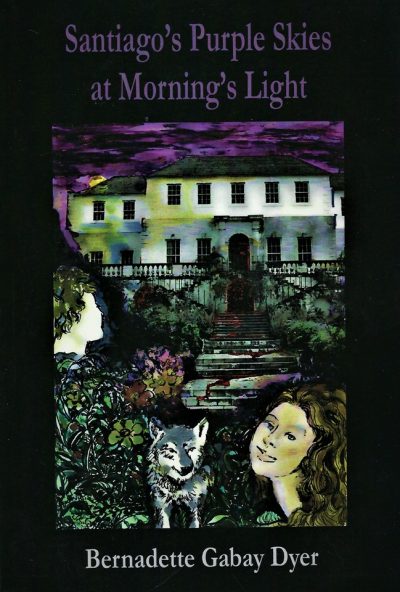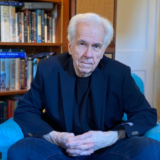
OBIR: Occasional Biased and Ignorant Reviews reflecting this reader’s opinion.

Santiago’s Purple Skies at Morning’s Light – by Bernadette Gabay Dyer
Published: in 2019 by Hidden Brook Press, Presqu’ile Park, Ontario, Canada.
Edited by: Richard M. Grove
Cover Art: Bernadette Gabay Dyer
Premise:
A newly-orphaned young lady from small-town Ontario winds up coming of age on a Caribbean island that, like her, is haunted by legends of its past.
Review:
I have a confession to make. Every since I was ten years old I’ve been fascinated with Haiti. In the summer cottage my family rented that year the only book, found in a drawer, was a pocketbook with a lurid cover depicting a man waving a machete against the backdrop of a field of burning sugar cane. If I remember correctly he supported an unconscious woman with his other hand, and both he and she wore torn shirts exhibiting considerable amounts of bosom. Possibly it was a Harlequin Romance. I remember that it was dull to read, with way too much love interest for a ten-year-old boy, but suddenly came alive with a massive slave revolt that I found exciting and quite amazing, having never heard of such a thing. I assumed it was entirely a work of fiction and gave full marks to the author for a vivid imagination.
In time I learned it was about the revolution that gave Haiti its independence from the French. Three formidable Haitian rulers, one after the other, drove out the French, thwarted an English attempt to conquer, and defeated the French again when they tried to come back. Not till the Americans imposed a Cuba-like blockade did Haiti sink into poverty and insignificance. Emperor Christophe, the Stalin of Haiti, was something of a mad genius. So, too, the cruel yet subtle Dictator Papa Doc Duvalier, a contemporary of mine, whom I consider one of the most fascinating monsters who ever lived. And then there’s Voodoo. In short, a country shaped by blood and suffering and a desperate struggle at all times against all odds.
Haiti, incidentally, has nothing to do with the setting of this novel, which is about the Island of Jamaica. And yet, it does, in a way peculiar to me. I know, or used to know (my memory is slipping) a great deal about Haiti. Of Jamaica all I had was an impression of good rum, Bob Marley and Reggae music, the Rastafarian movement, and high levels of gang violence. That’s it. And, oh, yeah, that it was a British colony, and until I read a good deal of British history, tended to assume that meant a peaceful, law-abiding and rather pleasant island, albeit dull and boring. Too civilized to be interesting which, of course, shows what ignorance will get you.
Point is, in hearing about this novel written by a Jamaican-born author living in Toronto, my curiosity was aroused. How would Jamaica compare to Haiti? What is Jamaica really like, as revealed from an insider’s point of view? What is “the truth” about Jamaica, its culture and lore?
Besides, I published a story by Dyer, titled Just a Single World, a rather surreal tale set on Mars, in issue #7 of my Polar Borealis Magazine, and I was curious to see how she would handle a 400-page fantasy-horror novel.
Plus, having been self-isolated since March 14th, the thought of slipping into the ambience of an exotic tropical island through the vision of someone who knows what she is writing about had immense appeal.
In sum, three good reasons for me to pick up the novel and read it. So, I did.
First impression: there’s an eerie sense of timelessness. I’m hard put to identify the decade in which the bulk of the novel takes place. There are automobiles and trains and airplanes, for instance, but no specific details as to type. No sign of cell phones or computers, or even television. The character’s father makes his living repairing broken things like locks, watches, blenders, lamps and radios, so we know her early life is spent in the pre-digital age. Especially since she often accompanies her father on his expeditions to Ottawa to pick up mechanical spare parts, not a single chip-driven gizmo in sight. No mention of politics. No mention of current events. The book is devoid of the usual contemporary detail a reader habitually expects. Is this an accidental flaw? A careless writer overlooking the obvious?
Not a bit of it. The choice is quite deliberate. The when is not important. Instead the author focuses on characterization and rich, not to say lavish, description of the Jamaican landscape, life-style, and the belief system underpinning it all. This brings Jamaica vividly to life. Yes, tourists are present. Yes, the Jamaican economy is geared to catering to tourists and relieving them of as much money as possible. But this isn’t about the tourist point of view. This isn’t a “How I spent my summer vacation in Jamaica” exercise. Tourists, the outsiders, are mere background noise, something to take for granted, exploit, and otherwise ignore. This is a novel about the Jamaican mindset and how they view reality. Something which is very different from the modern, North American interpretation of “Life, the Universe, and Everything” in many subtle and not-so-subtle ways. Something quite nostalgic and attractive about it, eternal rather than ephemeral, and spiritual rather than material. If the tourists can be equated with the Ancient Romans, then the native Jamaicans are more like the ancient Egyptians.
Of course, I’m generalizing wildly and being simplistic to beat the band but, hey, isn’t that what critics do? Never mind Freemasonry, us reviewers got secret rules to follow that the public knows nothing about. But I digress. Point is the specific focus on the timeless aspects of Jamaican life enables the reader to feel the Jamaican ambience is all of a piece in which past and present mingle and reinforce each other. This makes the fear of ghosts, the very presence of ghosts, all the more credible. A ghost is a Duppy, and Duppies are taken for granted. Like cougars and bears where I live. I don’t expect to see one, but I take care not to wander about the forested slopes of Mount Benson (which I can see from my living room window) in the middle of the night. A sensible precaution. Jamaicans take sensible precautions, too, only the monstrous predators they fear are rather different. Mind you, more interesting as well. The White Witch Woman is said to ride a three-legged horse Duppy, and you can tell it is passing by your hut at night because of the peculiar pattern of clip-clop noise its hooves make. Tends to make you wide awake when you think you hear a horse approaching. Not a good idea to look outside.
In her introduction Bernadette states her writing goal was “to blur reality so it is hard for a reader to surmise what is fiction and what is based on reality.” She succeeds admirably. Even better, the timelessness expressed in her descriptive technique renders the past horrifically relevant to the present. In a sense, the Duppies are just as “alive” as they ever were, just as malevolent and threatening as, for example, when the White Witch Woman, Annie Palmer, was a living plantation owner conducting a sadistic reign of terror at Rose Hall. In other words, coming into her presence then, you had reason to fear. The author makes it easy to believe that coming into Annie’s Duppy presence now offers equal reason to be afraid. You may not believe in ghosts, but the ghosts certainly do. Rationality is not much of a refuge when you meet one. Dyer makes that very clear.
Back to characterization. It’s the key to understanding what is going on in this novel, even more than the actual events as the plot unfolds. In her introduction Dyer says, in reference to the main character Kathleen, “Even though, perhaps subconsciously, attempting to escape the traumas of her past, she finds that encounters with the supernatural are as prevalent while away, as they were at home in Canada. It is almost as though the demons of the past continue to follow her every step…”
Isn’t that giving too much away? Not really. It is a relatively simple parallel that the reader quickly becomes aware of as soon as Kathleen gets to Jamaica. It becomes apparent that she may be doomed to experience the tragedy of her parents’ fate, to suffer the influence of the wild, so to speak. The power of the supernatural. But what is actually going on is far more complex. You might say her life as a child was mere preparation to what she confronts after her 16th birthday.
Tom Dunkley, her father, was rather shy and preferred to avoid people. He travelled to Ireland to research family history, but found the task too intimidating. Instead, he wandered the countryside to experience Ireland rather than the Irish, there meeting Carlita O’Brien as they both shelter under a tree from a violent storm. She’s very beautiful and very mysterious, knowing quite a bit of traditional Irish lore and seeming to be something out of that lore herself. Both see in each other their last chance to live, and wind up happily married in a farm house just outside the tiny town of Siddon, Ontario.
Kathleen is born, and is beloved by both parents. Alas, Carlita harbours a secret, unhappy past, yet grows bored with her newfound happiness. She takes to wandering in the woods for hours at a time. Tom avoids the woods because he fears the “dangerous northern beast” which hunts him, a danger he visualizes as a wolf. It is an irrational fear, but he can’t shake it. Meanwhile, Carlita meets with a “wolf” of her own, an embodiment of the wild. The two parents grow apart. Tragedy ensues. Kathleen winds up being cared for by the midwife who delivered her. After her 16th birthday Kathleen decides to start her own life in Toronto. The midwife provides the address of a friend who might possibly be willing to put her up for a while, which turns out to be the first step in a journey to distant Jamaica.
Because of her intimate knowledge of her father’s fears, and of her mother’s habits and knowledge, Kathleen already takes for granted the existence of supernatural forces, and even entities. So, when she confronts her first ghost in Jamaica, she doesn’t suffer from a predictable reluctance to accept what she sees, but assumes it is real and takes it for granted, just as many of the Jamaicans she’s already met do. Her instinctive reaction is not to tell anyone about it. For two reasons which seem very Jamaican. It is not that she’s afraid no one will believe her, for she knows most will. She’s worried she will be considered impolite, much in the sense that modern doctors in Japan don’t tell cancer patients they have cancer. Too intrusive. Besides, to state the obvious is to state the obvious. Why be gauche? Secondly, she’s worried another, more dangerous, ghost is influencing or even threatening one or more of her friends, so best to keep quiet till she learns what the supernatural world is planning. Hers is a coping strategy, potentially interactive, rather than a rigid state of denial. I find this approach rather different and refreshing.
An elderly Canadian-Jamaican gentleman by the name of Walker T serves as both mentor and guide. He seems excessively polite and civilized, an oasis of calm certainly when compared to the denizens of the modern rat race (pre-pandemic that is). Laid back and relaxed, he is a sort of icon for the Jamaican life style. Yet, like Kathleen, he suffers from an unbearably tragic past and, again like her, doesn’t so much deny the past so much as regard it as spilled milk and best to simply get on with life. That he doesn’t talk about it has nothing to do with shame or regret; he just doesn’t want to bore people. In today’s world of compulsive confession on social media, this old-fashioned restraint is positively nostalgic. One of the character’s strengths. Yet, under the pressure of unexpected, dangerous circumstance, he is willing to share his suddenly relevant past. Quite a practical man when push comes to shove. Though, being quite elderly, he is rather fragile when confronted by too many of his fears. A most sympathetic character.
There are quite a few characters in this novel, many of them not only significant to the plot but also interrelated through the actions of their ancestors to a degree unsuspected by the living. The activities of the supernatural elements turn out not to be random at all, but the inevitable consequences of past events. This greatly aids the process of bringing all the loose threads closer and closer to each other. It turns out that even the weirdest manifestations of the ghosts, good and evil, make sense, given the logic behind their supernatural motivation.
All of the characters are interesting for the reader to meet, each in their own way a charming insight into Jamaican life. Yet most conceal complex and difficult lives behind their polite nature. I won’t say “polite façade” since their behaviour isn’t forced, it’s quite natural, It is the nature of the culture to be friendly and polite, perhaps exaggeratedly so when fleecing tourists. Woes and problems are shared only with those you know well, and sometimes not even then. A brother and sister team of poverty-stricken children who befriend Kathleen never tell her they’re running their tiny farm by themselves while their mother lies abed with illness. Charmingly, on first seeing her, a white woman, they assume she’s the White Woman Witch Duppy. On learning otherwise, they feel sorry for her occasional to-them-witless wandering about the countryside and are eager to guide her. At one point they intervene to save her life. Not once do they mention their own problems. Those she hears about from someone else.
If the subject of this novel were different, if the setting was somewhere else, the background culture more what a WASP like me is used to, this reluctance on the part of multiple characters might seem a trifle redolent of an author holding back useful information (a flaw often seen in movies) in situations where most people would have blurted out their immediate fears right away. Usually withholding needful information is done to build suspense, though if it’s too obvious it can arouse resentment in the reader, or viewer.
Recently I re-watched the 1960 movie Beyond the Time Barrier. It’s quite clear the test pilot has flown through a time warp. Throughout most of the film he keeps saying things like, “I don’t understand. I took off at eight this morning and when I returned the airfield was abandoned and everybody gone. Where did all you mutants come from anyway?” The character is evidently incredibly dense. Apparently the film makers assumed the audience was as well. The fact that he took off in 1960 and landed in 2024 is supposed to be a shockaroo revelation late in the movie. It isn’t. Doesn’t work.
But there is no flimflam on the part of the author in this novel. A reluctance to be confrontational in terms of discussing unpleasant experience is entirely characteristic of both Kathleen, coping with past trauma, and the Jamaicans she gets to know who are inhibited by cultural restraints that are normally greatly to their advantage. Canadians are notoriously polite, and here I am saying ditto for Jamaicans. Am I implying we are very similar? Well, many Canadians are jerks. So, probably, are many Jamaicans. Human nature will out. Still, on a sliding scale, I have the impression Canadians are more reserved than Americans, less openly gung-ho about everything. Jamaicans, perhaps more openly friendly than Americans, appear in this novel to be even more reserved than Canadians, less concerned with the negative aspects of life, perhaps.
To those who believe all foreign nations are really America (or Canada) in disguise, and that there is no cultural difference in human behaviour whatsoever, the above paragraph will be nonsense, mere splitting of hairs. To which I say, I believe culture influences behaviour. I spent some time in Mexico and Guatemala in 1981, and found men’s attitude toward women remarkably different. More macho in Mexico. More polite in Guatemala. But then, the latter was at the height of its civil war at the time, and maybe people had more reason to be polite. Still, the dissimilarity in the two culture’s attitude toward women struck me as something more than the product of my imagination, something very real.
Since Dyer was born and raised in Jamaica, spending most of her life there, I tend to believe her portrayal of Jamaicans and Jamaica is accurate, and the differences in attitude and culture apparent to me quite intentional and equally accurate and therefore genuine. Of course, I may be reading too much into the book but then I always do. I’m not giving you 100% objective judgement of the actuality of the book so much as my impressions. Par for the course there.
The fact remains I wanted to know what is unique and attractive about Jamaica and Dyer delivered, from local manners to a sense of what it is like to actually live in Jamaica. I’m quite pleased. The view is not all one-sided. Poverty, crime, and racism are touched upon, but in an entirely Jamaican context. The initial languid pace may fool you, but it helps set both the characters and the setting, and then picks up as the plot thickens. Ah yes, what about the plot?
I haven’t said much about the plot. It is a horror fantasy novel after all, full of ghosts and centred on no less than two haunted houses. In an expansive mood I could compare it to Scooby-Doo episodes or go back as far Bob Hope’s 1940 film The Ghost Breakers or the classic 1927 haunted house mystery The Cat and the Canary (I’m more familiar with ghost movies than novels about ghosts), but I won’t. I’ll simply state that the novel features elements you probably anticipate, such as secret doors, hidden passages, skeletons, apparitions, pagan rituals and the like, but again, entirely within a Jamaican context that adds a freshness and a vigour to scenes that might otherwise be deemed cliché. To put it another way, this be a highly original work of fiction.
CONCLUSION:
My initial fascination with this novel depended on the element of discovery, on Jamaica being revealed. First I slipped into the scenery, then, much intrigued, into the mindset of the characters. Finally, I got caught up with the action and couldn’t wait to see what would happen next. Consequently, I found this book satisfying on multiple levels. It left me wanting to read up on Jamaica’s history.
Best of all, this novel does Jamaica proud. If you have even an ounce of curiosity about Jamaica, and appreciate a whopping good ghost tale, this book is for you. Recommended. I know you will enjoy it. I certainly did.
Check it out at: < Santiago’s Purple Skies >










